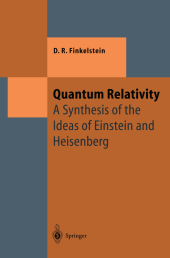 Neuerscheinungen 2012Stand: 2020-01-07 |
Schnellsuche
ISBN/Stichwort/Autor
|
Herderstraße 10
10625 Berlin
Tel.: 030 315 714 16
Fax 030 315 714 14
info@buchspektrum.de |

David R. Finkelstein
Quantum Relativity
A Synthesis of the Ideas of Einstein and Heisenberg
Softcover reprint of the original 1st ed. 1996. 2012. xxii, 578 S. XXII, 578 pp. 14 figs. 235 mm
Verlag/Jahr: SPRINGER, BERLIN 2012
ISBN: 3-642-64612-3 (3642646123)
Neue ISBN: 978-3-642-64612-6 (9783642646126)
Preis und Lieferzeit: Bitte klicken
Over the past years the author has developed a quantum language going beyond the concepts used by Bohr and Heisenberg. The simple formal algebraic language is designed to be consistent with quantum theory. It differs from natural languages in its epistemology, modal structure, logical connections, and copulatives. Starting from ideas of John von Neumann and in part also as a response to his fundamental work, the author bases his approach on what one really observes when studying quantum processes. This way the new language can be seen as a clue to a deeper understanding of the concepts of quantum physics, at the same time avoiding those paradoxes which arise when using natural languages. The work is organized didactically: The reader learns in fairly concrete form about the language and its structure as well as about its use for physics. The author presents a simple algebraic quantum language sharpening and deepening that of Bohr, Heisenberg, and von Neumann, with its own epistemology, modal structure, and connectives. The core of the language is semigroup of physical actions. The work extends quantum algebra from first-order to high-order propositions, classes, and actions; from positive to indefinite metrics; and from quantum systems to quantum sets, quantum semigroups, and quantum groups. The reader learns the theory by applying it to simple quantum problems at gradually higher levels. The author applies the extended quantum theory to a spacetime structure, which was taken as a fixed part of the classical framework of the original quantum theory. This leads to a simple proposal connecting the internal variables of spin, color, and isospin with the fine structure of spacetime.
To avoid paradoxical interpretations of quantum physics which have their origin in the use of natural language the author develops, starting from John von Neumann´s fundamental papers, a quantum language based on algebraic concepts. It starts from observations and is therefore well- suited for providing a better understanding of the foundations of quantum physics. The work is organized didactically and can be read by both physicists and philosophers of science.


